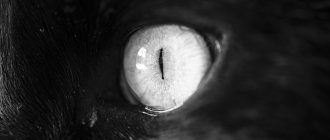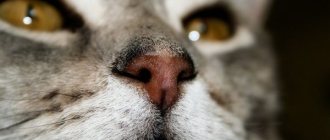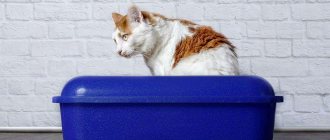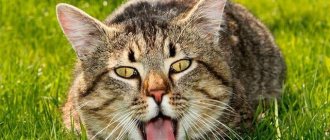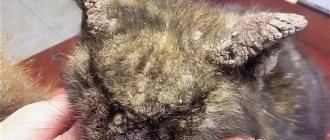A runny nose in cats is a fairly common phenomenon. Unlike people, colds in cats are not always easy and without consequences. Therefore, if you discover rhinitis in your pet, you should immediately contact a veterinarian for prompt treatment.
The main causes of runny nose in cats are a number of phenomena:
- hypothermia is the main cause of rhinitis in cats. Despite the presence of fur and the general belief that cats are the most tenacious creatures, they do not like drafts and long stays in cold air, as well as damp rooms;
- infectious diseases, colds, viruses;
- the cat’s reaction to household chemicals, perfumes, cigarette smoke and other mucosal irritants;
- the use of drugs that affect the condition of the mucous membrane;
- fungi, bacteria;
- the presence of indolent diseases not directly related to the nose;
- polyps, tumors;
- ear infection;
- contact with the nasal mucosa of a foreign body;
- congenital pathologies;
- worms, helminths, other parasites.
How to treat a cat
Before you begin treating your cat, you should find out the cause of the sneezing. A visit to the veterinary clinic, a visual examination and tests will help you choose the right therapy.
The owner is required to:
- strictly follow the doctor’s recommendations,
- give your cat medications on time,
- Regularly treat (rinse, instill) the nose of a sick animal.
On a note! During therapy, the animal's diet should be changed. A runny nose negatively affects a cat's sense of smell, and poor sense of smell negatively affects digestion. During illness, it is worth choosing food with a pronounced aroma.
Dangerous causes requiring special attention
- Viral, infectious and fungal diseases . Leukemia, immunodeficiency, rhinotracheitis, calicivirus and other dangerous diseases include sneezing in the list of symptoms. These diseases are fatal without timely diagnosis and treatment. At risk are kittens, pregnant and elderly animals, as well as animals picked up from the street or taken from shelters. It is important to understand that vaccination also does not provide 100% protection against infection and these diseases cannot be ruled out even in vaccinated pets!
- Tumors and polyps . If you notice that your pet has constant nasal congestion, sneezing and a runny nose, then one of the reasons may be a new growth in the nasal passage. To diagnose such a problem, you need to go to the clinic for an examination. Most likely, a rhinoscopy (using an endoscope) will be required to remove this tumor.
- Asthma . If, in addition to sneezing, your pet experiences wheezing, shortness of breath, or coughing, this may be a manifestation of asthma. In this case, you should contact the clinic for a more accurate diagnosis and prescription of medications.
- Dental problems . Often sneezing occurs due to dental problems. At the same time, the pet rubs its mouth and nose with its paws, and it often has difficulty eating. Examine your cat's oral cavity: if you notice plaque on the teeth, redness of the gums, an unpleasant odor, or drooling, you should consult a dentist.
- Worms . Infection can manifest itself in different ways, including a runny nose with wheezing. If you notice abnormal bowel movements, weight loss, dull hair, or a rounded belly, you need to get tested and treat parasites with medications recommended by your doctor.
In these cases, it is dangerous to self-medicate a runny nose; you need to go to the clinic as soon as possible.
You need to go to the vet urgently if:
- the cat sniffles, breathes with its mouth open;
- in addition to mucus, blood or pus is discharged from the nose;
- there is an increase in temperature - the pet has a hot nose and paw pads;
- there is redness of the eyes, lacrimation, and formation of pus;
- lethargy, anxiety, refusal of food and water, weight loss are manifested.
Treatment of a runny nose in a cat with medications
When a runny nose is diagnosed, the animal is treated according to the following scheme:
- prescribing antipyretic drugs for fever,
- the use of drops, solutions to facilitate breathing,
- prescribing expectorants for coughs,
- taking vitamins to strengthen the immune system,
- prescribing antibiotics for complications.
Be sure to read:
The cat is coughing and wheezing, how to treat it at home
Commonly prescribed medications:
- Intranasal drops "Anandin" - stimulate the immune system.
- Naphthyzin nasal spray - used to rinse the nasal passages.
- Xylometazoline nasal drops make breathing easier.
The correct dosage is prescribed by the doctor.
Symptoms of rhinitis in cats
There are signs that will tell you that your furry pet is suffering from rhinitis. These include:
- Difficulty breathing. After active actions, running or playing, the animal's breathing becomes heavy. Swollen nasal passages do not allow sufficient oxygen to be received; the cat gasps for air.
- A state of detachment, indifference to everything around. The animal falls into apathy; games, entertainment and treats do not interest him.
- The cat is trying to put its nose in order on its own, scratching the diseased organ with its paw, moving it over furniture and other objects.
- The temperature may rise (up to 39 C), the cat’s nose becomes hot.
- Often a runny nose is accompanied by conjunctivitis, the cat's eyes swell, and pus collects in the corners.
- Nasal discharge.
The types of rhinitis vary, as does nasal discharge. The acute form of a runny nose is characterized by copious clear discharge. When a cat sneezes frequently and endlessly rubs its nose on furniture and other objects, there is reason to think about allergic rhinitis. If the cause of a runny nose is a viral infection, the discharge from the animal's nose will be the color of pus.
When rhinitis is caused by damage to the inner lining of the nose, the discharge is bloody and flows from only one nostril. With any type of rhinitis, crusts of dried discharge are visible under the animal’s nose.
Traditional methods of treating a runny nose
At home, runny nose in cats is treated using folk remedies.
To rinse the nasal sinuses use:
- weak salt solution (20 grams of sea salt per glass of boiled water),
- soda solution (half a teaspoon per 200 ml of liquid),
- furatsilin,
- boric acid solution (a pinch per glass of boiled water).
For treatment, instillation is used:
- beet juice (1 drops of freshly squeezed juice per tablespoon of water),
- aloe leaf juice (one drop in each nasal passage 3 times a day).
Inhalations based on fir and eucalyptus oils will help your cat. Pour hot water into the container, add 3-4 drops of medicinal oil, hold the animal near the container for 5-10 minutes.
What causes a runny nose in cats?
There are several reasons. They are caused by improper nutrition and care of the animal, arise as a result of infection, or are a concomitant disease with oncology or other serious pathologies.
- Purebred pets often suffer from allergic rhinitis. This is how their body reacts to plant pollen, chemicals, medications, cleaning products, and cosmetics.
- A runny nose can be one of the signs of a serious infectious disease - pneumonia, tuberculosis.
- Rhinitis sometimes appears in an animal after prolonged hypothermia, ingestion of cold food or water.
- Hot air and steam can cause a runny nose. When a cat is near boiling water for a long time, or its fur is dried with a hairdryer, its body may react with acute rhinitis.
- The presence of foreign objects (fluffs, grains of sand) in the nasal passages also causes a runny nose.
- Oncological diseases that are localized in the nasal passages.
Cat flu: symptoms
Cat flu, the symptoms and treatment of which raise many questions, has an incubation period of 2-10 days. The virus can be transmitted from a sick animal, for example, in a nursery, or from a carrier through airborne droplets. The principle of virus penetration into the body is the same as in humans - through the mucous membranes of the oral cavity and through the conjunctiva of the eyes. The contact variant is less common - through products, sleeping accessories, cups, etc.
Article on the topic Medical battalion at home. How to organize treatment for a pet
A clear sign of cat flu is a runny nose. Also among the symptoms indicating pathology are:
- sneezing;
- conjunctivitis;
- increased body temperature;
- febrile conditions.
Also, a sick cat will be tired and weak; it will eat less or refuse to eat at all. If the cat's flu is caused by a calcivirus, it is milder. The situation becomes much more complicated if a bacterial infection is added. Then the cat may develop:
- pneumonia;
- bronchitis;
- chronic rhinitis.
This situation may occur if there is an outbreak in the cat population.
The hamster has infected! What diseases are transmitted from animals to people? More details
Treating a cat for sneezing
Only a veterinary specialist at the clinic can prescribe the correct treatment for a cat with symptoms of sneezing. If, during a clinical examination of your cat, a veterinarian determines that your cat is clinically healthy, he will recommend that you wet clean your apartment and use a special humidifier.
If the cause of sneezing is allergic in nature, then recommendations will be given to eliminate the allergen present in the apartment or to ensure that household chemicals are inaccessible to your cat. In order to alleviate the condition, a veterinarian will prescribe one or another antihistamine to your animal.
Causes and symptoms
Sneezing and discharge in an animal can be caused by infectious and non-infectious causes. Depending on this, you need to build treatment.
Colds and hypothermia
Cats have a very high immunity, and colds - so frequent and even commonplace for humans - are rather an exception to the rule for an animal. Colds and runny noses are more common in homeless cats during periods of cold and rain. Colds occur for several reasons:
- The room is too damp, drafty.
- High humidity.
- Lack of vitamins, poor nutrition.
- Sudden temperature changes.
- The animal is hypothermic or wet (this can happen if the cat, for example, is not dried well after bathing).
Symptoms that will indicate a cold:
- Dry or, conversely, hot nose.
- Hair loss or dullness.
- Great lethargy.
- The cat sleeps for a long time or gets very scared of something that didn’t bother her before.
- Weakness (the animal stands well on its feet, but is apathetic), increased fatigue.
- Decreased appetite.
With a cold, breathing becomes difficult, the snot is clear and not viscous. The cat sneezes and coughs heavily, and the eyes may water. If discharge sticks to the muzzle or crusts appear, this means that the disease is becoming serious and may progress to the pathological stage.
An animal can breathe through its mouth to facilitate the process of obtaining oxygen, but if this happens constantly and the nose is not involved, you should immediately consult a doctor.
Allergy
If the animal sneezes, tries to constantly rub its eyes and nose, and discharge of a transparent texture appears from the eyes, most likely, we are talking about an allergic rhinitis. The snot in this case is liquid, transparent in color (odorless), and may be accompanied by swelling and dermatitis. Breathing is impaired and itching is likely.
REFERENCE
Cats can develop allergies to a certain product. After consultation with a veterinarian and tests, he will have to be ruled out. There may be allergies to medications, pollen, house plants, and even household items. Most often, the animal reacts to the irritant after several hours, but symptoms can appear several days after encountering the allergen.
Fungi and bacteria
Human ARVI, most often, is not transmitted to cats, but if the disease is caused by certain fungi and bacteria, then both the owner and the pet can become infected with a runny nose.
A bacterial infection is indicated by:
- unpleasant smell of discharge and its yellow-green color;
- accumulation of pus in the corners of the eyes or over the entire surface;
- snot from the nose and tears from the eyes;
- constant sneezing and coughing;
- the animal constantly swallows, this is due to the fact that mucus accumulates in the nasopharynx;
- body temperature rises;
- loss of appetite;
- dehydration;
- prolapse of the third eyelid.
Fungal infections overwhelm animals with weak immunity and often the runny nose becomes chronic. An indicator of a bacterial infection is a crust in the nose, which makes breathing very difficult and snot comes out of the nose.
Important! If the polyps have grown, the animal's face will become deformed. This is dangerous because the inflammation spreads to the brain; the symptoms of this are seizures.
Video about runny nose in cats:
Foreign bodies
Coughing and sneezing may be caused by a cat swallowing a foreign object in its intestines or esophagus. If this happens, the symptoms will be as follows:
- Profuse salivation.
- If a foreign body is in the throat, then coughing and wheezing appear, the tongue turns blue, and the cat may lose consciousness.
- Constant swallowing.
- Vomiting and belching.
- Complete lack of appetite.
- Bloating.
- Lethargy, apathy, drowsiness.
- Diarrhea, constipation.
- Symptoms of general intoxication.
Congenital pathologies
A runny nose can result from birth defects and injuries. For example, a “cleft palate,” that is, disturbances in the structure of the upper jaw and nasal bones, will cause the cat difficulty breathing and wheezing. Injuries to the jaw or head can result in a cleft palate. The bones can become displaced, and all this together will give the animal a chronic runny nose.
Important! If rhinitis does not go away for a long time or occurs periodically, be sure to contact your veterinarian.
With such pathologies, the discharge does not have an unpleasant odor and most often does not affect the general condition of the cat (if the injury is cured and is not life-threatening). To clarify the causes of chronic runny nose, you should contact your veterinarian. He will identify the pathology and tell you whether it is possible to treat it or eliminate the symptoms.
Inflammation (ears, teeth, gums)
A runny nose can be an indicator of inflammation that occurs in the nasopharynx or ears. And it will not go away until the initial inflammation is removed.
Why do cats get ear infections?
- Infections.
- Hypothermia.
- Other specific diseases.
Why gums and teeth can become inflamed:
- Malocclusion.
- Lack of vitamins.
- Caries.
- Tartar.
- Injury.
- Irradiation.
- Virus.
- Chemical poisoning.
With inflammation, the following clinical picture is observed:
- breathing quickens;
- discharge from the eyes becomes watery;
- the animal periodically breathes through its mouth;
- sneezing occurs infrequently;
- purulent snot, gray-green, whitish, yellow, sometimes even with traces of blood;
- loss of appetite.
Other causes of runny nose
Other problems that cause coughing, sneezing and sniffles include:
- Parasites, for example, worms.
- Tumor of the nasopharynx.
- Neoplasms.
- Chronic diseases.
- Infections.
- Stress.
Diagnostics in a veterinary clinic
When the first signs of a runny nose appear, the animal must be shown to a veterinarian. By resorting to self-medication, the owner of a kitten can aggravate its condition, because delay or incorrectly prescribed treatment can contribute to the development of a serious illness and life-threatening complications.
At a veterinary clinic, various examinations may be required to prescribe effective treatment. Depending on the abundance and color of the discharge, blood tests, a nasal swab, swabs from the conjunctiva, mucous membranes of the gums and pharynx are prescribed, and rhinoscopy (examination of the nasal cavity using special instruments) may be prescribed.
All this is necessary to establish the true cause of the animal’s illness and timely detection of viral infections or other dangerous pathologies.
Prevention of rhinitis
The best protection against rhinitis is vaccination. While vaccines are the best defense against viral diseases, they are not 100% effective and the viruses that cause this condition are widespread.
- Vaccination of a cat before mating.
- Avoid exposing kittens to other cats until at least one week after the second vaccination.
- Frequent bedding changes (cat viruses are often spread through body fluids.
- Separate sick cats from healthy cats as soon as possible.
(c) Veterinary center for the treatment and rehabilitation of animals “Zoostatus”. Varshavskoe highway, 125 building 1. tel. 8 (499) 372-27-37

